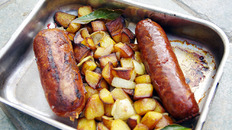Meats and Sausages
Saucisse de Morteau
Saucisse de Morteau or Jésus de Morteau is a French sausage that has been awarded PGI (21.08.2010) European certificate of origin. The sausage is made from pork and it is stuffed into a 34 mm natural pork casing for a sausage weighing <150 g and 40 mm for a sausage weighing >150 g. It is closed at one end by a straight wooden stick without any sharp ends, and by a string made of natural fiber at the other end.
Jésus de Morteau is a particular form of Saucisse de Morteau but it is packed into pork caecum (blind cap) which is irregular and much bigger. Jésus de Morteau has less regular appearance and its diameter is at least 65 mm at the time of filling. Jésus de Morteau is not always closed by a small wooden stick when a caecum casing (blind cap) is used. Both sausages are made from the same recipe. Smoking gives Saucisse de Morteau and Jésus de Morteau a typical amber color, oscillating between brown and golden.
Saucisse de Morteau/‘Jésus de Morteau is produced in the Franche-Comté region (Doubs, Jura, Haute-Saône and Territoire de Belfort). A dominant feature of Franche-Comté landscape is its large, mainly coniferous, forest, particularly in the mountainous zone. Local sawmills abound in the area allowing this resinous wood to be processed on site, providing the fuel required for traditional smoking. The agriculture in the Franche-Comté region depends to a large degree on cattle farming and local cheese dairies known as fruitières. They produce a number of great cheeses and also byproduct known as whey, which is a choice raw material for animal feed, in particular for pigs.
In the past, the meat was cut simply using a knife, both for the fat and the meat. Today, the meat is ground, however, a coarse mince is still preserved. The cuts that may be used are as follows (no other cuts are permitted): leg, shoulder, belly, back fat, loin, pork trimmings. Mechanically separated meat is not permitted and minced meat particles must be at least 8 mm in size. Salt (NaCl) is added at maximum level of 22 g/kg and this limit is accepted among local producers. Sugar, nitrite salt or saltpeter (sodium nitrate) are allowed, as well at red wine in the amount of 6.5% and rosemary extract (for its anti-oxidizing properties, not for its aroma).
The maximum temperature for drying is 40°C (104° F). The purpose of drying is to prepare the surface of the casing for optimum adherence of smoke. The smoky flavor is one of the major characteristics of Saucisse de Morteau and Jésus de Morteau and is due both to the sawdust and resinous wood used and to the duration of the smoking process. Saucisse de Morteau/Jésus de Morteau exhibit a typical amber color, somewhere between brown and golden. The minimum period for smoking within a conventional smokehouse is set at 3 hours, the maximum at 48 hours. For smoking in a ‘thué’, or traditional smokehouse, the minimum period is 12 hours, the maximum period 7 days. A maximum temperature of 40°C (104° F) for smoking in a conventional smokehouse is added. This helps prevent any deterioration in quality. The use of liquid smoke is forbidden.
During cooking the sausage must reach the core temperature of minimum of 68° C (154° F).
| Meats | Metric | US |
|---|---|---|
| Pork meat (shoulder, ham, loin) | 700 g | 1.54 lb |
| Pork back fat, belly | 300 g | 0.66 lb |
Ingredients per 1000g (1 kg) of meat
| Salt | 18 g | 3 tsp |
| Cure #1 | 2.0 g | 1/2 tsp |
| Pepper | 2.0 g | 1 tsp |
| Coriander | 1.0 g | 1/2 tsp |
| Cumin | 1.0 g | 1 tsp |
| Nutmeg | 1.0 g | 1/2 tsp |
| Garlic | 7.0 g | 2 cloves |
| White wine | 30 ml | 1 oz fl |
Instructions
- Grind meat through 5/16” (8 mm) plate.
- Grind fat through 5/16” (8 mm) plate.
- Mix ground lean meat with salt and cure #1 until sticky. Dilute spices in wine and pour over meat. Add ground fat and mix all well together. Stuff into 40 mm hog casings.
- Smoke for 48 hours with a thin cold smoke at 18° C (64° F). Original sausages are smoked with local wood such as pine conifer, fir and juniper twigs.
- Keep in refrigerator.
- Cook before serving.


















